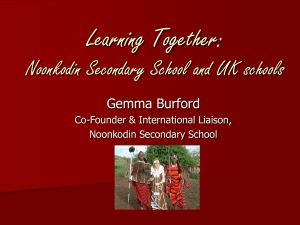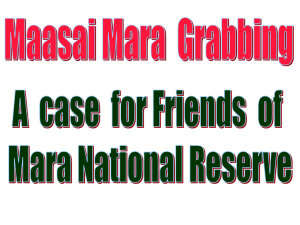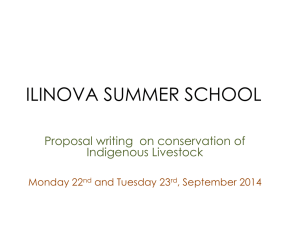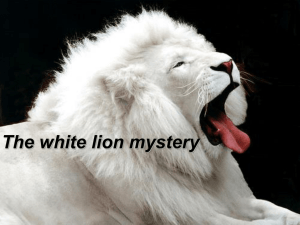other lale`enok programs
advertisement
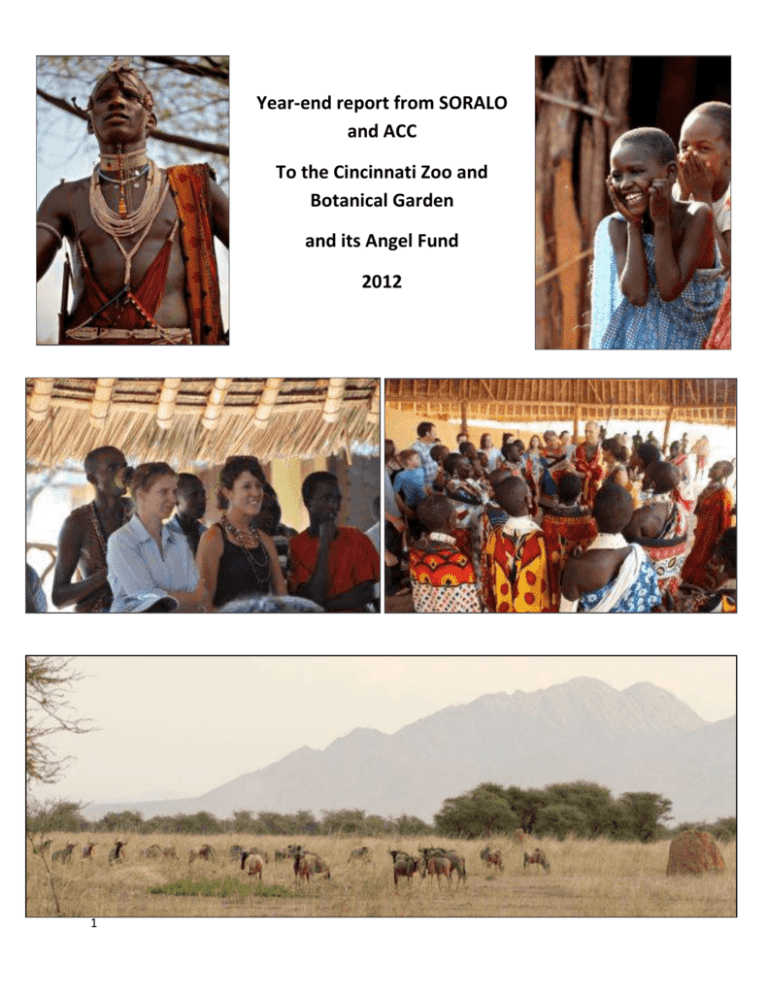
Year-end report from SORALO and ACC To the Cincinnati Zoo and Botanical Garden and its Angel Fund 2012 1 INTRODUCTION The year 2012 brought many small but significant changes to SORALO and its work in the South Rift including: Revamping the Resource Assessor program and successfully streamlining it with the information needs of the local community Expanding the Rebuilding the Pride work (including deploying 5 lion GPS collars, conducting cross comparisons with Amboseli and developing a conflict mitigation response team) Focusing on launching the Cultural Heritage program and its associated Shield Project An expansion of the network of conservancies in the region A revision of the Game Scouts program A revision of the roles and responsibilities of key SORALO personnel It was a significant year also for the development of the relationship between SORALO and its work and the Cincinnati Zoo. Not only did Lale’enok host Thane and Kathleen Maynard and their visitors from the US but recognition of achievements spread both ways across the Atlantic with John Kamanga being awarded the CZBGs Wildlife Conservation Award, and Thane Maynard being made an honorary Maasai elder. MONITORING AND RESEARCH Lale’enok is first and foremost a centre for the generation of information, the main outcome from the variety of monitoring and research programs running there. The information is collected by both local community members and resident or visiting scientists, and its application spans across a variety of end users. Much of 2012 has been spent streamlining and improving upon the quality and relevance of the information collected. - GENERAL ECOLOGICAL MONITORING Basic river height measurements, vegetation monitoring and wildlife counts were conducted periodically over this year, thanks mainly to Lily Maynard and Guy Western who took up the coordination in Samantha’s absence. A permanent weather station is based at Lale’enok which automatically records rainfall, humidity, wind speed and temperature. This information continues to provide the backdrop for all other projects and helps situate and explain much of the information collected in the other programs. However, this information needs better coordination in the future and we have plans to look at more manageable and appropriate data collection methods. 2 - LIVESTOCK AND LIVLIHOODS A key focus for research in the South Rift centres around issues of livestock as one of the key factors which contributes to local livelihoods. Conservation efforts will be futile without attention to these issues. Data on livestock is best collected by those who understand the issues the best; in our case our local Resource Assessor team. Information is collected on all aspects of livestock husbandry, including information about herding patterns and strategies, disease prevalence, cattle condition and also captures major concerns of livestock keepers. This information not only is linked to the general ecological monitoring, since many of the decisions of livestock owners centers around basic ecological parameters such as water and forage availability, but also is integral to the work of Rebuilding the Pride. - RESOURCE ASSESSOR REVAMP This year has also been a year of transition for the resource assessor program, with official funding ending from ACC. This signaled a time to reflect on past successes and challenges and pilot new ways of taking the program to the next level and into the future. The interim phase, which took place between June and December, included the following: Assessing and closing phase I. It was important to look back at the work done since the inception of the RA’s program and its progression over the last four years so that we can draw lessons for a new phase intended to start in 2013. This involved: 3 Developing a revised Resource Assessor program which not only continues to support key elements of data collection (perhaps a limited set of Phase 1 data) and explores and pilots new approaches and strategies. This involved: Cleaning up Phase 1 data, analyses of these data and production of a final report, which is in progress. This included hiring two full time data entry personnel in order to clear the backlog of data. Information dissemination from Phase 1 (both within ACC/SORALO/ACP and local communities). This took place in limited ways as part of the series of meetings held at Lale’enok to discuss the program in general. Reviewing information needs from the community. Setting up the whole cycle of information management from data design, collection, entry, management, analyses and feedback. Ensuring that the information collected is fully integrated with the needs of other key stakeholders, including ACC, SORALO and researchers. A series of meetings were held at Lale’enok in order to achieve what is outlined above. Much time was spent discussing the appropriate methods of data collection and feedback techniques. Discussions involved many members of the community whose livestock form part of the study, and it was clear that there was a real interest in the findings of the study and that the overall goals of the program are relevant. One meeting in the series included the Resource Assessors from Amboseli along with key members of the Amboseli Ecosystem Trust, who came to Lale’enok to see for themselves what has been achieved so that they can better inform the development and management of the Amboseli Resource Centre which is in progress. 4 The meeting culminated in a final planning meeting on December 7th, which included all the resource assessors, selected herd owners, community leaders and researchers. The framework for an annual plan, with the following information feedback strategy was agreed upon: Weekly summaries of the findings of each herd from the resource assessor to the herd owner. Monthly resource assessor meetings at Lale’enok to compare across the study area the results from the weekly summaries. Local researchers and other stakeholders can be invited to present relevant information for discussion also. Quarterly community feedback meetings involving selected community leaders, herd owners and representatives from grazing and settlement committees, researchers and resource assessors. This in effect aims to revive dormant community management committees, and use the resource assessor program to provide the information on which they can base management decisions. - REBUILDING THE PRIDE NEW GPS COLLARS Over the last two years Rebuilding the Pride’s team of local Maasai research assistants have tracked the movement of both livestock and lions in an effort understand seasonal movements and identify conflict hotspots. This year the team’s ability to monitor lions has been greatly improved through the use of GIS technology. Thanks to the CZBG and a great team effort including support from the game scouts, we were able to deploy GPS collars on five lions between June 5th and 10th. Three females (named Eramatare, Namunyak and Nasha) and two males (Oldere and Ren) were collared. The GPS collars transmit four locations a day to a central server giving detailed information on the exact movement of the collared animals, information that has been helped safe guarding the lion population and livestock in the area. In conjunction with the game scouts and research assistants Rebuilding the Pride has been able to advise herders when to change their grazing strategy so as to avoid lions thus preventing potential conflicts. Active engagement with herders and herd owners has reduced the likelihood of conflict but also helped to build stronger relationships with the wider community. Tracking of livestock and lion movements has started to reveal that lions, rather than actively seeking out livestock as in many parts of Kenya, are displaced by the seasonal movements of people and livestock. The two figures below show the locations for Oldere (one of our collared males) over two months. Figure 1 shows his positions for the month of July prior to people moving into the area. It shows that he spent most of his time along the river, which runs down the right side of the map. Figure 2 shows his locations after people moved into the area. 5 People settle along the river and if you look closely you can see several settlement sites. People essentially moved into the lions core range which he had been using the previous month. In response, Oldere appears to avoid areas with Maasai settlement and his core range shifted considerably with movement of people into the area. On several occasions while tacking collared individuals we also have found the lions lying up in the thickets within a 100 meters of where cattle had been grazing several hours previously. With the aid of GPS collars the team has started to document and reveal the unique balance of coexistence that exists between predators and people in the Olkiramatian/Shompole area. Fig 1: Oldere movements pre-settlement Fig 2: Oldere movements post-settlement CONFLICT RESPONSE TEAM In April 2012, Rebuilding the Pride created a conflict response team which quickly proved invaluable. Following a week of high conflict where nine cows were killed, analysis of lion locations, livestock movements and livestock predation revealed that conflict was isolated to four key areas, all of them thickets through which livestock had to pass to access grazing. Our team, in collaboration with local leadership, community game scouts and KWS, was able to mitigate the conflict through the resurrection and adaptation of traditional herding practices. Traditionally when Maasai herded livestock into areas of high predation risk, the elders would join go out to join the herders late in afternoon to aid in bring the cattle home safely and 6 livestock all would use the same trail to reduce the likelihood of conflict. To reduce the incidence of conflict the community game scouts (all seasoned herders in their own right) took on this role, acting as livestock guardians to ensure the safe passage to livestock through conflict hotspots. The local herd owners also agreed to help by ensuring that all livestock must follow the same trails through conflict hotspots and cut short their grazing hours to ensure livestock were safely home by the early evening. The strategy proved successful and in the preceding weeks no livestock were lost to lions. Information and reporting has also been essential to preventing conflict. Thanks to reports from games scouts, research assistants and the local community, our team has been able to help find and rescue countless lost livestock that would have otherwise fallen victim to predation. In one week alone, thirteen cows were rescued. POPULATION DYNAMICS Thanks to the work of the local community, SORALO and Rebuilding the Pride, the delicate balance of coexistence persists in Olkiramatian and Shompole allowing lion populations to continue to grow. Since July thirteen cubs have been born with another litter being expected early in 2013. This recent proliferation of cubs takes the current lion population up to a minimum of fifty-seven lions, with potentially more unknown individuals in the lesser studied areas around the conservancies. Through our tracking and monitoring efforts Rebuilding the Pride has been building up a photographic identification database of all the lions within the area, an effort that has revealed that there are currently five resident males in the conservation areas, not three as we had previously thought. The influx of males into the area indicates links to other lion populations in surrounding areas and demonstrates the potential for conservation and long-term viability of the South Rifts lion’s populations. CROSS COMPARISONS AND LESSONS FROM AMBOSELI Rebuilding the Pride acknowledges the fate of the African lion depends on their continued presence outside of protected areas. Survival of lions outside the protected area matrix requires local involvement in conservation of large carnivores. Lion conservation organizations in Kenya operate within a broad socio-economic, ecological, cultural and historical sphere. The future of lion conservation depends on the answers to several key questions: 7 Are species-focused lion conservation organizations compatible with the core principles of CBC? Do the CBC and species-focused lion conservation efforts foster positive perceptions of lions and promote lion conservation? What is the best conservation approach for promoting co-existence between lions and local communities? Rebuilding the Pride attempted to answer these questions using a cross comparison Maasai lion relationships in Olkiramatian/ Shompole and Amboseli. The comparison revealed that conservation organizations focusing specifically on human-lion conflict reduce community ownership of lions and absolve communities of the individual responsibility of mitigating conflicts. The result is a heightened perception of conflicts and a less positive perception of lions. By contrast, broad community-based conservation (CBC) efforts are built upon and help maintain the integrity of Maasai-lion relationships and foster community ownership of the conservation process. CBC creates positive feedbacks between communal benefits and lion conservation propagate positive perceptions of lions. Cooperation and a sense of community lie at the heart of Maasai society and are the foundations on which traditional coexistence is based. Rebuilding the Pride’s research demonstrated that the success of lion conservation in southern Maasailand requires that coexistence is not only preserved within Maasai society, but also reinforced among conservation organizations with which they work. Species focused conservation programs and CBC must work in tandem, not isolation. Lion focused species conservation should therefore embed their efforts in broader CBC programs rather than treat them in isolation. Local institutions such as SORALO should be responsible for the development of locally based governance, with the assistance of government agencies, NGO’s, academics and conservation institutions where needed. Technical strategies for conserving lions such as education programs, appropriate land use, and a focus on supporting livelihoods must build and work through community institutions and adopt a case-by-case approach. Lion conservation efforts should aim at developing remedial strategies that communities want to and can adopt, rather than imposing those they don’t and can’t sustain. Strategies such as education and compensation are important but again should build on community inclinations and capacity rather than undermine them. Mitigation measures that are based on traditional knowledge and are locally and culturally relevant will achieve greater success than those that are developed externally and imposed. As stated by an elder interviewed, traditional Maasai-lion coexistence provides a solid foundation for developing lion conservation strategies: “The Maasai know how to live with lions, we do not need to separate people and wildlife for we have learned how to move around one another. For conservation to succeed, it must maintain this balance between livestock and wildlife.” 8 Rebuilding the Pride’s research findings has helped to validate the community driven approach to conservation which SORALO champions and guide the future development of Rebuilding the Prides conservation agenda. Rescuing a sick cow Cubs, cubs and more cubs 9 Nasha and Collar Measuring lion footprints and monitoring interactions. THANK YOU CZBG FOR SUPPORTING LILY TO SUPPORT US Rebuilding the Pride was able to function so effectively as a project in 2012 thanks to the capable and cheerful support of intern Lily Maynard. Many thanks go to her for not only holding the fort while Guy Western was away on study leave, but also taking up much of the Lale’enok general coordination in Samantha’s absence. 10 OTHER LALE’ENOK PROGRAMS - SCOUTS Lale’enok is now home to all Olkiramatian scouts and the coordination base across the South Rift. Scouts conduct morning and afternoon patrols, man access points into the conservancies (Gate 1), and take visitors into the conservancies. It has been a challenge to streamline salaries and work schedules across all the SORALO conservancies but progress has been made. In December two Olkiramatian scouts were posted to the Loita Hills, to the North West of Olkiramatian, to investigate recent reports of an increase in elephant poaching. It appears that this area may be a focus for SORALO’s conservation efforts in 2013 given its importance to the South Rift elephant population. - EDUCATION In July 2012, we organized the first in what we hope will become a series of school interaction days at Lale’enok. As part of the usual community interaction day that is a part of the annual Earth Expedition visit, we invited local school children to participate in presenting to the visitors plays, songs, poems and artwork centered around the theme of ‘lions are a benefit to us’. The idea was to give them a chance to reflect upon their relationship with the animals and give them a chance to investigate this relationship with their parents and peers. It was a great success both in terms of the quality of the performances, but also in the fact that the majority of the audience were community members, who listened with keen (and sometimes shocked) ears to hear what the younger generation had to say. Local Olkiramatian primary school children were reunited with the Maasai Music Project children from the US, and presented a song which they had written together. 11 As a thank you for participation, the Lale’enok team agreed to organise night drives for all the children to see the lions. This is yet to be arranged but is high on the priority for 2013. - BEADS FOR LION CONSERVATION The CZBG are engaging in a project directly with the womens group of Lale’enok. Beads symbolize the Maasai people, and thus what better way to celebrate the efforts of the South Rift Maasai in the conservation of lions than to wear Maasai beaded bracelets. In line with this thinking, the Zoo aims to sell the Olkiramatian womens bracelets at the upcoming opening of their African lion exhibit. This not only provides income to the women that comes directly as a result of their conservation efforts, but also helps raise awareness for the coexistence that exists between Maasai and lions in the South Rift. - VISITING GROUPS Lale’enok continued to be a popular destination for a number of education groups this year, including McGill University, the Swedish University of Agricultural Sciences, Earth Expeditions and the Maasai Music Project. In addition, Lale’enok hosted Anna Campbell, a budding wildlife and conservation film maker, who produced a short but effective documentary on Rebuilding the Pride. http://www.annacampbell.tv/films Lale’enok also hosted Thane Maynard and his visitors from the US in a very special visit. Thane was made an honorary Maasai elder in recognition of his work for conservation and community support both in Cincinnati and in Kenya. 12 Thane Maynard as a newly appointed Maasai elder GENERAL SORALO DEVELOPMENTS - CULTURAL HERITAGE PROGRAM LAUNCH The first step in the development of the cultural heritage program was a workshop held at Olorgesailie in September 2012, which brought together over seventy representatives of various Maasai sections (from across Kenya) to discuss what it means to be ‘Maasai’ and to identify the main threats to Maasai culture. In summary, being Maasai centers around the various customs and traditions such as the way the society is divided into age groups, clans and sections and everything about the way the Maasai live. In particular, the Maasai hold respect as a value above almost all others. Many of their traditions are as a direct result of showing respect for one another and for the land on which they live. The biggest threats are seen to be religion, education and a decline in respect for elders and Maasai customs. The women stressed that money corrupts values and explained how outsiders buying up land and settling in Maasai areas is eroding the integrity of their culture. Here, interactions with other cultures lead to new interests and values that undermine traditional Maasai ways. 13 Many suggestions were put forward as to how to rekindle Maasai culture, including stopping the sale of land, adding a cultural curriculum into schools and making time for family instruction at home to children. Strong support came through for the proposed idea of a cultural heritage center and annual festival where the Maasai as a people can meet, discuss their culture, collect artifacts and knowledge and teach and celebrate customs. The center and legal institutions will help authenticate and uphold Maasai traditions and practices that represent them, their image and products. Following the workshop there was the formal launch of the Maasai Cultural Heritage Program. In keeping with Maasai tradition the site for the proposed Maasai cultural museum, the physical base for the program, was blessed by elders as the local women sang and unloaded their donkeys as they would before setting up a new home. The key people who addressed the crowd and also gave their support followed from the local community leaders included the Chairman of the African Conservation Centre (ACC) Dr. David Western, the Executive Director of ACC Mrs. Lucy Waruingi, Dr. Rick Potts from the Smithsonian Institution an institution of the National Museums of United States of America, the Director of Sites & Monuments of the National Museums of Kenya Dr. Hassan Wario and the guest of honor the Permanent Secretary of the Ministry of State for National Heritage and Culture , Dr. Jacob Ole Miaron. 14 A month later, at Lale’enok, eight elders of the Olkiramatian community held a workshop to make the first authentic Maasai war shields in perhaps fifty years. Leading the workshop were two men who carried shields as young men, Karinte ole Manka and Tonkei ole Rimpaine. They were joined by their age-mates Ntetyian ole Pasoi, Sipala ole Mpoe and Marikiti ole Kalempu. Four women also assisted. The team produced two full shields from cowhide, goatskin, and pigments made of earth, blood, bone and milk. ConserVentures provided photography and videography services and will be producing books, posters and film for the Maasai Cultural Heritage project. 15 - EXPANSION OF CONSERVANCIES In the last 15 years some 127 conservancies have been established on community and private lands in Kenya, accounting for more wildlife than all protected areas combined. A number of new conservancies have been developed in the South Rift recently, some by SORALO directly, and others by other communities who have then approached SORALO for support. 16 As indicated in the map above, there are at least 9 conservancies in the South Rift region in various stages of development: Shompole and Olkiramatian are the longest running and most established, followed by Suswa. These three have mainly been established by SORALO and ACC. Empaash Olorionito has been set up by a group of Maasai landowners and is now being supported by SORALO in terms of salaries for their local game scouts. Olorgesaile and Kwenia are in the early stages of disucssion, and the conservation efforts here will focus mainly on the Maasai Cultural Heritage program to begin with. The Namanga area to the East and the Loita hills to the West of SORALO’s working extent have had numerous conservation efforts established over the last decade, with variying success and again, SORALO has been asked to support these efforts in various ways. In the Loita hills for example, SORALO has been approached by the local community to investiagate reports of elephant poaching in the area. In early December, two Olkiramatian game scouts were deployed there to start ground recconniscence. Oldonyo Nyokie and Kabongo are two areas with significant tourism and conservation potential, and will be explored further in 2013. - SORALO PERSONNEL This year SORALO has tried to improve upon defining roles and responsibilities of key personnel in an effort to better manage and coordinate its rapidly growing portfolio of projects. To summarise: Samantha du Toit role within SORALO has expanded and she is now officially predominantly Nairobi and office based, with monthly field visits to Lale’enok. She is coordinator of SORALO’s Research and Education programs, as well as being in charge of running the conservation safaris and coordinating visiting groups to Lale’enok. This however does provide a challenge to ensure projects are well coordinated from both the office and the field, particularly as the projects continue to expand. Roles have continued to be streamlined and defined in an effort to improve overall coordination. Joel Njonjo is now the official Lale’enok naturalist whose roles and responsibilities include hosting the baboon walks, overseeing the local education outreach and he plays a vital role in the coordination of information from the resource assessor program. Albert Kuseyo is officially the Lale’enok Camp Manager and his roles and responsibilities include running general camp operations as well as assisting with the collection of ecological information. In addition, SORALO also employs the following personnel: 17 Guy Western as the coordinator of Rebuilding the Pride. Michael Lenaimado as the Conservation Manager for all of SORALO’s conservancies. He is overall in charge of game scout program. Rahab Wandir, who is SORALO’s administration assistant, based in Nairobi. Last, but of course not least, John Kamanga, overall coordinator of SORALO. In addition, SORALO is responsible for the coordination of and sourcing funds for: o 35 community game scouts o 15 resource assessors o 2 additional camp staff (watchmen and cook). CONCLUSION The year 2012 has seen the continued expansion of SORALO’s projects and increased attempts to streamline and improve upon existing programs at Lale’enok. The major challenges faced this year include: Ensuring good systems for information management are implemented. Ensuring the information collected is put into action. Mobility of field personnel, especially scouts. Coordination and implementation of the many programs in the field. These are challenges that we look forward to tackling in 2013. Finally, without the support of the CZBG, it would have been almost impossible to achieve what we have in the South Rift this year. Not only has the CZBG been the most generous and flexible of all donors to SORALO, but they have offered support in far more ways than just financial. Lily kept all the projects running almost single handedly for much of 2012, and both Dave Jenike and Thane Maynard brought groups to the centre, which is a highly underestimated form of support. Thank you and we look forward to hosting you both again in 2013. 18 19

